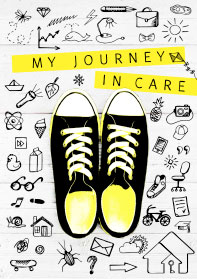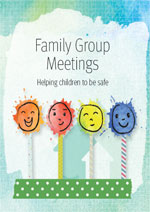Things to know about being in care
If you are child or young person who has come into care for the first time, there are things you need to know so you can be safe and cared for.
Family group meeting
A family group meeting family group meeting is where important people in a child or young person’s life meet to discuss what is working well for them and their family and what is not working well. A plan is made to keep them safe and to make sure the child and their family receive the help and support they need. Decisions made and agreed upon will be included in a case plan. Learn more
Case plan
A case plan is a written agreement made between the child, their family and Child Safety. It sets out the best way to help the child stay happy and safe while they are in care and how they can achieve their future goals and dreams.
A plan may include:
- their goals and care needs, and how they can be met
- the needs of their family, and how they can be met
- contact arrangements between the child and their family members
- support available to the child
- how their parents will keep them safe
- who will be helping them and your family.
Cultural support plan
A cultural support plan includes information about how a child or young person will be supported to keep connected to their culture, family, and community while in care. A cultural support plan is included in the case plan for all Aboriginal and Torres Strait Islander children and children from culturally and linguistically diverse backgrounds. They are individual to each child.
People who are important to developing, maintaining, and supporting a child’s cultural identity will provide information about what should go in the child’s cultural support plan and what should be done to make sure the child’s right to develop, maintain and enjoy a connection with their culture of origin is upheld.
Education support plan
An education support plan helps children and young people get the most out of school and overcome problems they might be having with their education. The plan may include:
- what their education needs and goals are
- what help and support they need to reach their education goals.
Kicbox
For children and young people who live in care, it can be difficult to keep track of things like personal mementos, photos, records and documents that make up their life story.
kicbox is a private, digital memory box that keeps everything safe and in one place. It also provides a more convenient way for them to communicate and share information with their Child Safety team.
Child Health Passport
A Child Health Passport is a folder that contains information about a child or young person’s health. It is used to:
- give their carer information about their health so they can help meet their health needs
- help Child Safety and their parents (if this is okay with the child or young person) to understand their health and help them to be healthy.
Navigate Your Health
Navigate Your Health is a program to help young people to look after their health. As part of the program, they will have their own Nurse Navigator who will talk with them, their carers, their parents or another family member they trust, and their Child Safety Officer about the things they need to be healthy and well.
National Disability Insurance Scheme
The National Disability Insurance Scheme (NDIS) provides support for people who have a disability. The NDIS is managed by the National Disability Insurance Agency (NDIA) and is available across the whole of Queensland.
Standards of care
Sometimes, Child Safety may get serious information that a carer (foster carer, kinship carer or residential care worker) is not caring for children and young people properly.
If Child Safety gets concerning information about the standard of care being provided to a child or young person, the information is recorded. Child Safety will need to talk to the child or young person and their carer about the standard of care being provided.
Child Safety will ask for information about the care being provided by their carer so they can see if it meets the ‘statement of standards’ outlined in the Child Protection Act 1999.
It is important that carers meet the ‘statement of standards’.
Children and young people can ask their Child Safety Officer to explain the standards of care and to give them a copy of these standards.
Safety and support network
Children and young people get help and support from people in their safety and support network while they are in care to help keep them safe. The network includes the child or young person’s Child Safety Officer and may include members of their family, friends, people in their community, their foster or kinship carers, and other people who work for Child Safety and other organisations. The members of the child or young person’s safety and support network can also help uphold their right to have a say and be heard in decisions.
The different roles of some of the members of a child or young person’s safety and support network are explained below:
Foster or kinship carer — this is a person who offers to care for the child or young person when they cannot live at home. They may be from within their family or the community. They may have children of their own, care for children from different families or they may be a single person. Carers receive special training and have the skills to make sure they can care for kids.
Child Safety Officer (CSO) — this person works for Child Safety and has a responsibility to look out for the child or young person, and to see that their needs are being met. A Child Safety Officer will be the child or young person’s main contact in Child Safety, but they can also contact the team leader if the CSO is not available.
Child Safety Support Officer (CSSO) — this person also works for Child Safety providing extra support to help parents look after their children. They will be supporting the Child Safety Officer to get things done for the child or young person.
Community Visitor — this person works for the Office of the Public Guardian. They will visit the child or young person while they are in care to make sure they are being listened to, The Community Visitor will also help the child or young person with any issues they have and connect to people who can support them. Learn more
Child Advocate — this person is a lawyer who works for the Office of the Public Guardian. They can help and stand up for children and young people in the child protection system. A child or young person can call the Office of the Public Guardian on 1800 661 533 (free call from a telephone) to speak to a Child Advocate. They can support a child or young person in a court or tribunal, help with problems at school or with the police, and ensure that their views and wishes are heard by adults making decisions about them and their care arrangements. Learn more
CREATE Foundation — this is a community agency that offers a wide range of programs and activities to connect and empower children and young people in out-of-home care. A child or young person can call the CREATE Foundation on 1800 655 105 (free call). Learn more
Aboriginal and Torres Strait Islander children can also be supported by:
Cultural Practice Advisor – this is an Aboriginal or Torres Strait Islander person who gives advice to the child or young person’s CSO about how to understand and support the culture of Aboriginal and Torres Strait Islander children and their families. This person works for the Child Safety.
Independent Person — this is an Aboriginal or Torres Strait Islander person who can be a family member, friend or Elder chosen by the child or young person, their parent or family member to help them participate in discussions or meetings with Child Safety about significant decisions being made. This person does not work for Child Safety. Learn more Learn more
- Last reviewed
- 19 May 2023
- Last modified
- 3 August 2023
 This work is licensed under a Creative Commons Attribution 4.0 International (CC BY 4.0) licence
This work is licensed under a Creative Commons Attribution 4.0 International (CC BY 4.0) licence



